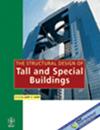考虑板效应的复合框架全寿命周期成本导向多目标优化
IF 1.3
3区 工程技术
Q3 CONSTRUCTION & BUILDING TECHNOLOGY
引用次数: 0
摘要
以生命周期成本为导向的设计理念是建设弹性城市的一个很有前途的工具,因为它有助于深入了解危害引起的破坏的影响以及民用和基础设施系统的修复。在这项研究中,通过结合与不同损害极限状态相关的经济损失率和基于云分析的概率地震需求模型,引入了一个独立于社会经济参数的实用公式,用于全生命周期成本分析。利用一种新兴的自然启发算法,即多目标布谷鸟搜索,提出了基于寿命周期成本分析的抗震设计优化框架。通过考虑八层原型复合框架,该框架用于确定竞争优化目标之间的权衡设计方案。建立了传统和改进的纤维模型,对比评价了楼板空间复合效应对帕累托最优设计的影响。使用广义线性模型确定了三个成本指标变化的关键驱动因素。结果表明,超强度系数是影响初始结构、震害和寿命周期成本的关键设计参数,在0.001水平上具有统计学显著性。本文章由计算机程序翻译,如有差异,请以英文原文为准。
Life‐cycle cost‐oriented multiobjective optimization of composite frames considering the slab effect
The life‐cycle cost‐oriented design philosophy is a promising tool for building resilient cities as it helps in gaining insights into the impact of hazard‐induced damage and repair of civil and infrastructure systems. In this study, a socioeconomic parameter‐independent practical formulation was introduced for life‐cycle cost analysis by combining the economic loss rate associated with different damage limit states and cloud analysis‐based probabilistic seismic demand model. A framework for life‐cycle cost analysis‐based seismic design optimization was proposed using an emerging nature‐inspired algorithm, namely, the multiobjective cuckoo search. By considering an eight‐story prototype composite frame, the framework was used to determine the trade‐off design alternatives between competing optimization objectives. Conventional and improved fiber models were developed to comparatively evaluate the influence of the slab spatial composite effect on Pareto optimal designs. The key drivers of change in three cost indicators were identified using generalized linear models. The result indicates that the overstrength factor is the critical design parameter affecting the initial construction, seismic damage, and life‐cycle costs, with statistical significance at the 0.001 level.
求助全文
通过发布文献求助,成功后即可免费获取论文全文。
去求助
来源期刊
CiteScore
5.30
自引率
4.20%
发文量
83
审稿时长
6-12 weeks
期刊介绍:
The Structural Design of Tall and Special Buildings provides structural engineers and contractors with a detailed written presentation of innovative structural engineering and construction practices for tall and special buildings. It also presents applied research on new materials or analysis methods that can directly benefit structural engineers involved in the design of tall and special buildings. The editor''s policy is to maintain a reasonable balance between papers from design engineers and from research workers so that the Journal will be useful to both groups. The problems in this field and their solutions are international in character and require a knowledge of several traditional disciplines and the Journal will reflect this.
The main subject of the Journal is the structural design and construction of tall and special buildings. The basic definition of a tall building, in the context of the Journal audience, is a structure that is equal to or greater than 50 meters (165 feet) in height, or 14 stories or greater. A special building is one with unique architectural or structural characteristics.
However, manuscripts dealing with chimneys, water towers, silos, cooling towers, and pools will generally not be considered for review. The journal will present papers on new innovative structural systems, materials and methods of analysis.

 求助内容:
求助内容: 应助结果提醒方式:
应助结果提醒方式:


